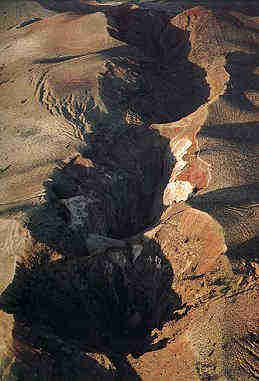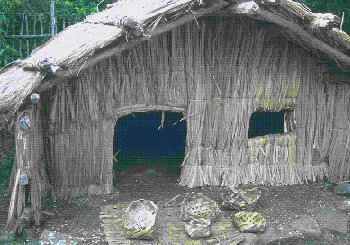![]()
Coasts
Rivers/Lakes
Lowlands/Plains
Geysers/Mud
Glaciers
Mt. Ruapehu
Mt. Cook
White Island
A Maori Legend
![]()
Abbotsford
Aramoana
Ballantynes
Brynderwyns
Cave Creek
Hawkes Bay
H.M.S. Orpheus
Influenza
Mt. Erebus
Mt. Tarawera
Rainbow Warrior
Seacliff Hospital
Tangiwai
Wahine
![]()
Annie Aves
Ata-hoe
Daisy Basham
Jean Batten
Minnie Dean
Mabel Howard
Margaret Mahy
Kath Mansfield
Kate Sheppard
Kiri Te Kanawa
Catherine Tizard
Murray Ball
Charles Goldie
Edmund Hillary
Richard Pearse
Lord Rutherford
Charles Upham
![]()
NZ FAQ--Funny
NZ Links
Credits
June 10th, 1886. On May 31st, 1886 two separate boat loads of tourists returned from a tour of the famous Pink and White Terraces to report having seen a fully-manned and dressed Maori war canoe, paddled by a dozen warriors, gliding past in the mists of Lake Rotomahana. Suddenly, when the canoe was about half a mile away it mysteriously disappeared. The local people knew there was no such boat in the area and as the people who sighted the vision were independent eye-witnesses, and disinterested persons, the sighting was the source of much discussion. Tuhoto, a 110-year-old tohunga, (Maori priest), claimed that the tourists had sighted a Waka- Wairua, (spirit canoe). He considered this be an omen of disaster, a portent of many deaths to come. Some people considered the apparition had simply been a mirage or reflection from their own canoe. But a strange tidal surge had occurred on the lake that morning. Whether or not one believes 'ghost' stories of this type a huge disaster followed soon after when, just eleven days later, Mt. Tarawera experienced a violent eruption killing an estimated 153 people and devastating the entire surrounding area. The death toll would have been much larger had it been the peak of tourist season as this eruption came without warning from a volcano that was previously long thought extinct. The numbers of those killed are vague and some place the count lower at 111. Reports had the volcanic roar heard as far away as Christchurch and a government geologist has estimated that more than two billion cubic yards of ash was scattered over an area of more than six thousand miles. Three craters on the mountain were split open to the base. People in Nelson, 300 miles distant, were awakened by booming noises they took to be a ship in distress far out to sea or possibly the Russians invading. Booming sounds were also heard by some residents of Christchurch. The dark ash cloud from Mt. Tarawera passed over Gisborne and Tauranga the next day turning daylight to night. During the course of the eruption some people were completely buried inside their houses. Others were forced to brave the night and seek shelter elsewhere. Many villagers made their way to the whare, (house), which belonged to the Maori guide Sophia, hers being one of the few buildings to survive the night. It's thought 62 people spent the night safely here and this was where guests from the collapsed Rotomahana Hotel sheltered. Once the eruption was over it was discovered that the only room in the hotel to have survived intact was the bar where not one bottle or glass had even been broken.
As far as Mt. Tarawera was concerned the eruption was over in only six hours however craters formed on the site of what had been Lake Rotomahana and these continued to be active until early August. The lake itself had emptied completely, having simply evaporated, the lake bed had been scooped out to at least 250 feet below its previous level. In its place was a steaming valley full of caters and steaming holes of sulphurous ash. Volleys of stones belched forth while steam rose from boiling polls of mud. For the following five years tourists crossed what had been the lake floor to view this thermal activity. Seven years after the eruption boiling water started to seep through the ground and within a week the lake had refilled. Today Lake Rotomahana covers 5600 acres and is 789 feet deep. The old lake was shallow and full of reeds, it covered only 284 acres and was only 32 feet deep. The end result of the eruption was that the topography of this area was completely changed. This area was world-famous for the Pink and White Terraces which were considered the eighth wonder of the world. Situated at the base of Mt. Tarawera people came from far and wide to view them. Over thousands of years the spray from a geyser had formed the terraces by leaving a silica coating over the surrounding area. It created a fan like staircase in beautiful shades of pink and white which covered about seven and a half acres, (3 hectares). The White Terraces, or Te Tarata, were a series of curved silica basins filled with turquoise blue water. The lowest basin was 800 feet long and the white terraces stood 100 feet high. The Pink Terraces rose more steeply, rather like a giant staircase, were as smooth as enamel and pink like coral. These were known by the Maori as Otukapuarangi, or 'Cloud in the Heavens'. Tourists would bathe in the warm waters of both terraces with the White Terraces offering a greater variety of temperatures while the Pink Terraces contained water that was softer and silkier. There is a story that Mark Twain had a photo of himself bathing au naturel superimposed on an image of two girls similarly bathing. He sent it to friends with the message, 'This is how I take my bath every day in New Zealand.' To this day no one has been able to identify the site of the Pink and White Terraces. Did the eruption shatter the terraces into fragments or simply bury them under layers of mud? Alfred Warbrick was one person convinced that the terraces were only buried: "Had they been shattered in that vast upheaval, a convulsion which threw debris thousands of feet into the air, is it not reasonable to assume that some fragments of the easily identified material which formed them, would have been found?" Yet pieces of sinter were found were found. The owner of the hotel claimed to have found numerous pieces on what remained of the roof of that building. In 1936 a large piece of sinter possibly from the Pink Terraces was located. An appeal from the DSIR for specimens of the terraces bought forward many, many fragments. Pieces were also found at Te Wairoa during 1979 when the level of Lake Rotomahana was unusually low. However, it should be remembered that there were many of sinter deposits around that general area with the Pink and White Terraces being just one so it's possible these fragments originated from elsewhere.
Alfred Warbrick was utterly convinced the terraces were only buried beneath the waters of Lake Rotomahana and he campaigned strongly for the Government of the time to artificially lower the level of the lake and commence a search. Tourists flying overhead often claim to have seen the terraces glinting beneath the waters of the Lake. It seems both they and Warbrick were wrong. Using old photographs taken from the upper level of the White Terraces a Government volcanologist investigated the locality of the terraces. His investigations showed that at the likely location of the White Terraces there is now just a vertical cliff face leading to the conclusion that Te Tarata was destroyed. The site of the Pink Terraces also lay in this zone so Otukapuarangi must also have been demolished. Over the years suggestions have been put forward that man-made terrace formations could be created by directing silica-rich waters over an artificial landscape. No one has yet solved the problem of how to recreate the unique colouring of the former Pink and White Terraces. Frighteningly, one of those caught in the eruption was a surveyor sent by the government to survey a new site for a hotel directly beside the terraces that were destroyed. Today, the best visitors can do is visit the Buried Village, the excavated ruins of the Maori village which once served as the starting point for tourists on their trip to the Terraces. This village was buried under nearly 2.5 metres of mud and debris during the 1886 eruption but, after extensive digging, remnants of several buildings may be seen including the tohunga's 'whare' or house. The old tohunga was blamed by many people for the disaster as he had predicted it based on the phantom canoe sightings. He survived the eruption, and was rescued alive after four days, only to die later in hospital. It is commonly said that it was not the eruption, nor the four days of being trapped, that killed this man. It was the bath they gave him in the hospital! Not far away Mt. Tarawera can be seen........sleeping.
|


 Three Maori villages were buried: the tourist
settlement of Te Wairoa where most of the buildings were destroyed
by a deluge of mud, and Te Ariki and Moura both of which were completely
obliterated, the people along with them. Te Ariki was buried under
thirty feet of mud. Moura slipped into the lake taking its forty
inhabitants with it.
Three Maori villages were buried: the tourist
settlement of Te Wairoa where most of the buildings were destroyed
by a deluge of mud, and Te Ariki and Moura both of which were completely
obliterated, the people along with them. Te Ariki was buried under
thirty feet of mud. Moura slipped into the lake taking its forty
inhabitants with it. 